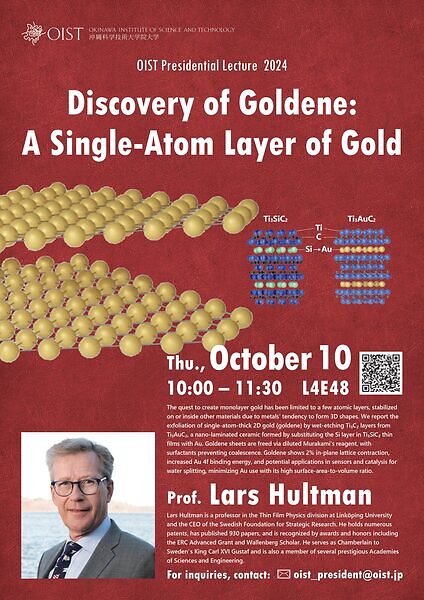Presidential Lecture by Prof. Lars Hultman
Discovery of Goldene: A Single-Atom Layer of Gold
The quest to create monolayer gold has hitherto been limited to a few atomic layers, stabilized on or inside another material. The bonding nature of metals is the root cause for gold’s tendency to form 3D shapes during all kinds of synthesis, like vapor-phase deposition or precipitation in solutions.
Here,
Kashiwaya and our team report the exfoliation of a single-atom-thick 2D gold (1) (which we name
goldene) by wet-chemically etching away Ti₃C₂ layers from Ti₃AuC₂, a nano-laminated MAX-phase (2) ceramic. This ceramic is initially formed by substituting the Si layer in Ti₃SiC₂ thin films with Au (3). The driving force behind such exchange substitution can be understood from the eutectic nature of the phase diagram for gold and silicon.
While gold nuggets were unearthed approximately 3000 years BC, silicon was discovered as a pure element in 1824 by the Swedish Chemist Jöns Jacob Berzelius. Recognizing that Japan has rich gold deposits, it is befitting that the discovery of goldene are made jointly by Swedish and Japanse scholars.
The goldene sheets are freed through etching with a diluted form of the famous Murakami's reagent (4). Surfactant schemes are applied to prevent goldene sheets from coalescing with each other in water suspension.
Goldene with roughly 2% in-plane (111) lattice contraction compared to bulk gold is observed by scanning transmission electron microscopy. A tendency for curling and agglomeration of goldene is observed, whereas ab initio molecular dynamics simulation shows that flat atomic layers are inherently stable. X-ray photoelectron spectroscopy reveals an Au 4f binding energy increase of 0.88 eV. Prospects for preparing goldene from a series of carbide and nitride MAX phases are also presented. Proposed applications for goldene include sensors and catalyst for water splitting during solar energy harvesting. The use of Au resources would be minimized due to the ultimate surface-area-to-volume ratio for goldene.
Professor Lars Hultman
Thin Film Physics, Linköping University, Sweden
CEO Swedish Foundation for Strategic Research
Lars Hultman earned his PhD in 1988 and became a Professor in 1998 at Linköping University. He has directed national centers of excellence and is currently a Visiting Chair Professor at Ming Chi University of Technology in Taiwan.
His expertise lies in materials science and the nanotechnology of advanced materials. His discoveries include a novel form of epitaxy, fullerene-like carbon nitride films, superhard nitride superlattices, and goldene. His patents cover plasma deposition, cutting tool and low-friction coatings, microelectronics diffusion barriers, neutron detectors, and catalysis. He has published 930 papers (H-index 105), including in Science and Nature, and collaborated with Nobel Laureates in Physics, Hiroshi Amano and Isamu Akasaki. He has mentored 50 graduate students and 20 postdocs.
Prof. Hultman serves as Chamberlain to Sweden’s King Carl XVI Gustaf and is a member of both the Royal Swedish Academy of Sciences (KVA) and the Royal Swedish Academy of Engineering Sciences (IVA). He is also a Fellow of the American Vacuum Society. His recognitions include an ERC Advanced Grant, Wallenberg Scholar, Akzo Nobel Science Award, Bunshah Award, Thornton Award, and roles such as Board Member of the Sweden-Japan Foundation and Swedish Public & Science VA, as well as Chair of the Advisory Committee for the Wallenberg Initiative Materials Science for Sustainability (WISE). He was a participant in the IVA Royal Technology Mission to Japan in 2016, led by the King.
***
1) Shun Kashiwaya, Y. Shi, J .Lu, D. Sangiovanni, M. Andersson, J. Rosen, Lars Hultman Nature Synthesis, 3 (April 16, 2024) 744-751
2) MAX phases are inherently nanolaminated hexagonal ternary metal carbides and/or nitrides with a general formula Mn+1AXn, where M is a transition metal, A is a group 13-16 element, X is carbon and/or nitrogen, and n = 1, 2, 3,... See review: M. Dahlqvist, M.W. Barsoum, and J. Rosen, Materials Today 72 (2024) Jan/Feb, p. 1 https://doi.org/10.1016/j.mattod.2023.11.010
3) H. Fashandi, M. Dahlqvist, J. Lu, J. Palisaitis, S. Simak, I. Abrikosov, J. Rosen,
Lars Hultman, M. Andersson, A. Lloyd-Spetz, P. Eklund Nature Materials 16 (2017) 814
4) Potassium ferricyanide is combined with potassium hydroxide (or sodium hydroxide ) and water to formulate Murakami's etchant. This etchant is used by metallographers to provide contrast between binder and carbide phases in cemented carbides. Takejiro Murakami (1882-1969) spear-headed the Tohoku Imperial University’s Materials Science research initiative. Until retirement in 1944, he was director of the Institute for Research in Metallurgy.
***
For inquiries contact: oist_president@oist.jp




